engine LEXUS RX450h 2015 Owner's Guide
[x] Cancel search | Manufacturer: LEXUS, Model Year: 2015, Model line: RX450h, Model: LEXUS RX450h 2015Pages: 878, PDF Size: 11.62 MB
Page 304 of 878
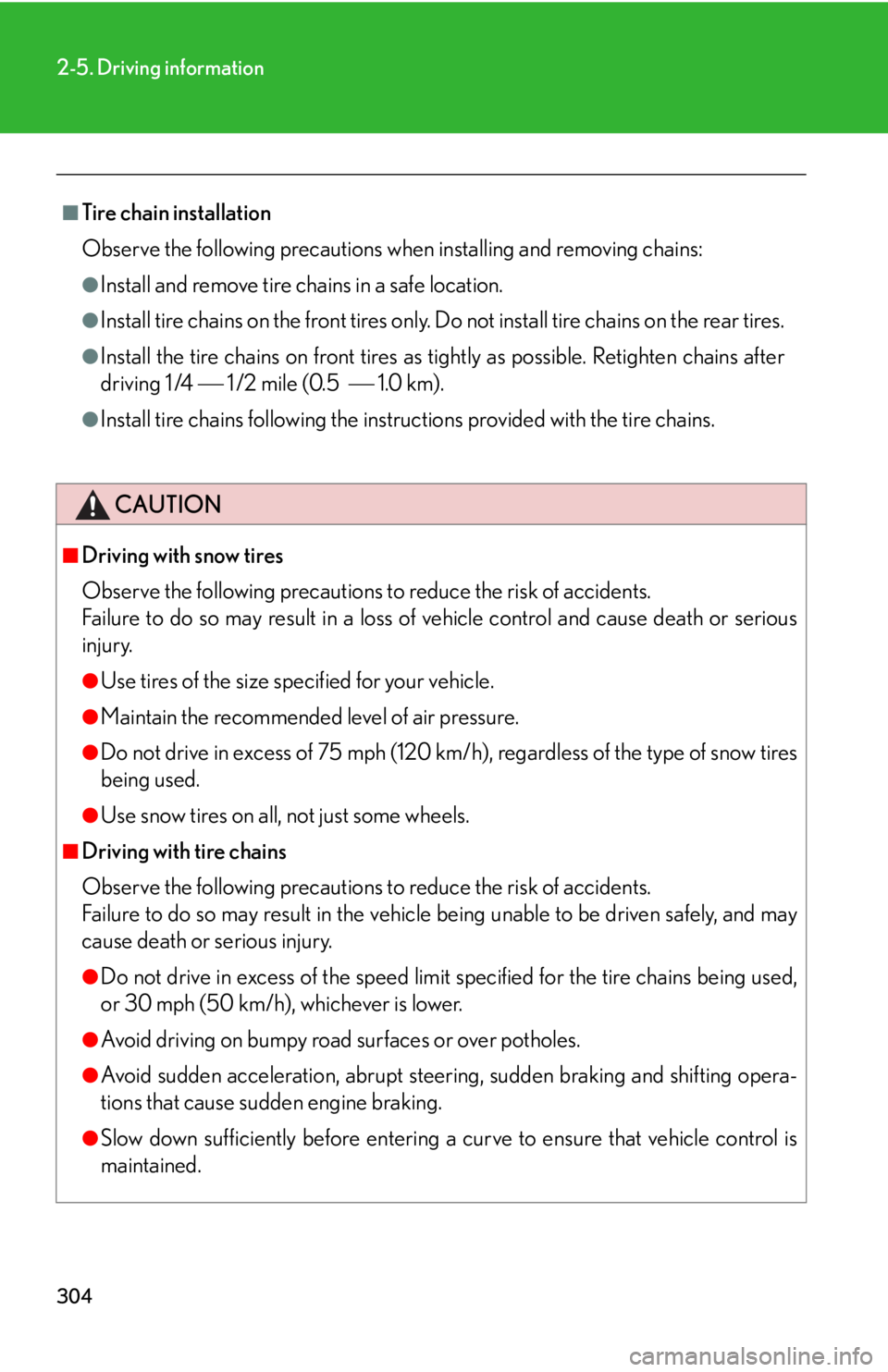
3042-5. Driving information
■
Tire chain installation
Observe the following precautions when installing and removing chains: ●
Install and remove tire chains in a safe location. ●
Install tire chains on the front tires only. Do not install tire chains on the rear tires.●
Install the tire chains on front tires as tightly as possible. Re tighten chains after
driving 1 /4 1/2 mile (0.5 1.0 km).●
Install tire chains following the instructions provided with the tire chains.
CAUTION■
Driving with snow tires
Observe the following precautions to reduce the risk of accidents.
Failure to do so may result in a loss of vehicle control and cause death or serious
injury. ●
Use tires of the size specified for your vehicle.●
Maintain the recommended level of air pressure.●
Do not drive in excess of 75 mph (120 km/h ), regardless of the type of snow tires
being used.●
Use snow tires on all, not just some wheels.■
Driving with tire chains
Observe the following precautions to reduce the risk of accidents.
Failure to do so may result in the vehicle being unable to be driven safely, and may
cause death or serious injury. ●
Do not drive in excess of the speed limit specified for the tire chains being used,
or 30 mph (50 km/h), whichever is lower.
●
Avoid driving on bumpy road surfaces or over potholes.
●
Avoid sudden acceleration, abrupt stee ring, sudden braking and shifting opera-
tions that cause sudden engine braking.
●
Slow down sufficiently before entering a curve to ensure that vehicle control is
maintained.
Page 317 of 878

3172-5. Driving information
2
When driving ● Avoid jerky steering and sharp turns, and slow down before making a
turn.
● Note that when making a turn, the tr ailer wheels will be closer than the
vehicle wheels to the inside of th e turn. Compensate by making a
wider than normal turning radius.
● Slow down before making a turn, in cross winds, on wet or slippery sur-
faces, etc.
Increasing vehicle speed can destabilize the trailer.
● Take care when passing other vehi cles. Passing requires considerable
distance. After passing a vehicle, do not forget the length of your
trailer, and be sure you have plenty of room before changing lanes.
● To maintain engine braking efficiency and charging system perfor-
mance when using engine braking, do not put the transmission in D.
● Instability happens more frequently when descending steep or long
downhill grades. Before descending, slow down and downshift. Do not
make sudden downshifts while descending steep or long downhill
grades.
● Avoid holding the brake pedal down too long or applying the brakes
too frequently. This could cause th e brakes to overheat and result in
reduced braking efficiency.
● Due to the added load of the trailer, your vehicle’s engine may overheat
on hot days (at temperatures over 85°F [30°C]) when driving up a
long or steep grade. If the eng ine coolant temperature gauge indicates
overheating, immediately turn off th e air conditioning (if in use), pull
your vehicle off the road and stop in a safe spot. ( P. 7 8 8 )
Page 320 of 878

3202-5. Driving information
■
Break-in schedule
If your vehicle is new or equipped with any new power train components (such as
an engine, transmission, differential or wheel bearing), Lexus recommends that you
do not tow a trailer until the vehicle has been driven for over 500 miles (800 km).
After the vehicle has been driven for over 500 miles (800 km), you can start tow-
ing. However, for the next 500 miles (800 km), drive the vehicle at a speed of less
than 50 mph (80 km/h) when towing a trailer, and avoid full throttle acceleration.■
Maintenance ●
If you tow a trailer, your vehicle will require more frequent maintenance due to
the additional load. (See “Warranty and Services Guide”, “Owner's Manual
Supplement” or “Scheduled Maintenance”.)●
Retighten the fixing bolts of the towing ball and bracket after approximately
600 miles (1000 km) of trailer towing.■
If trailer sway occurs
One or more factors (crosswinds, passing vehicles, rough roads, etc.) can adversely
affect handling of your vehicle and trailer, causing instability. ●
If trailer swaying occurs:
• Firmly grip the steering wheel. Steer straight ahead.
Do not try to control trailer sway ing by turning the steering wheel.
• Begin releasing the accelerator peda l immediately but very gradually to
reduce speed.
Do not increase speed. Do not apply vehicle brakes.
If you make no extreme correction with the steering or brakes, your vehicle and
trailer should stabilize. ●
After the trailer swaying has stopped:
• Stop in a safe place. Get all occupants out of the vehicle.
• Check the tires of the vehicle and the trailer.
• Check the load in the trailer.
Make sure the load has not shifted.
Make sure the tongue weight is appropriate, if possible.
• Check the load in the vehicle.
Make sure the vehicle is not ov erloaded after occupants get in.
If you cannot find any problems, the speed at which trailer swaying occurred is
beyond the limit of your particular vehicle-trailer combination.
Drive at a lower speed to prevent instability. Remember that swaying of the towing
vehicle-trailer increases as speed increases.
Page 347 of 878
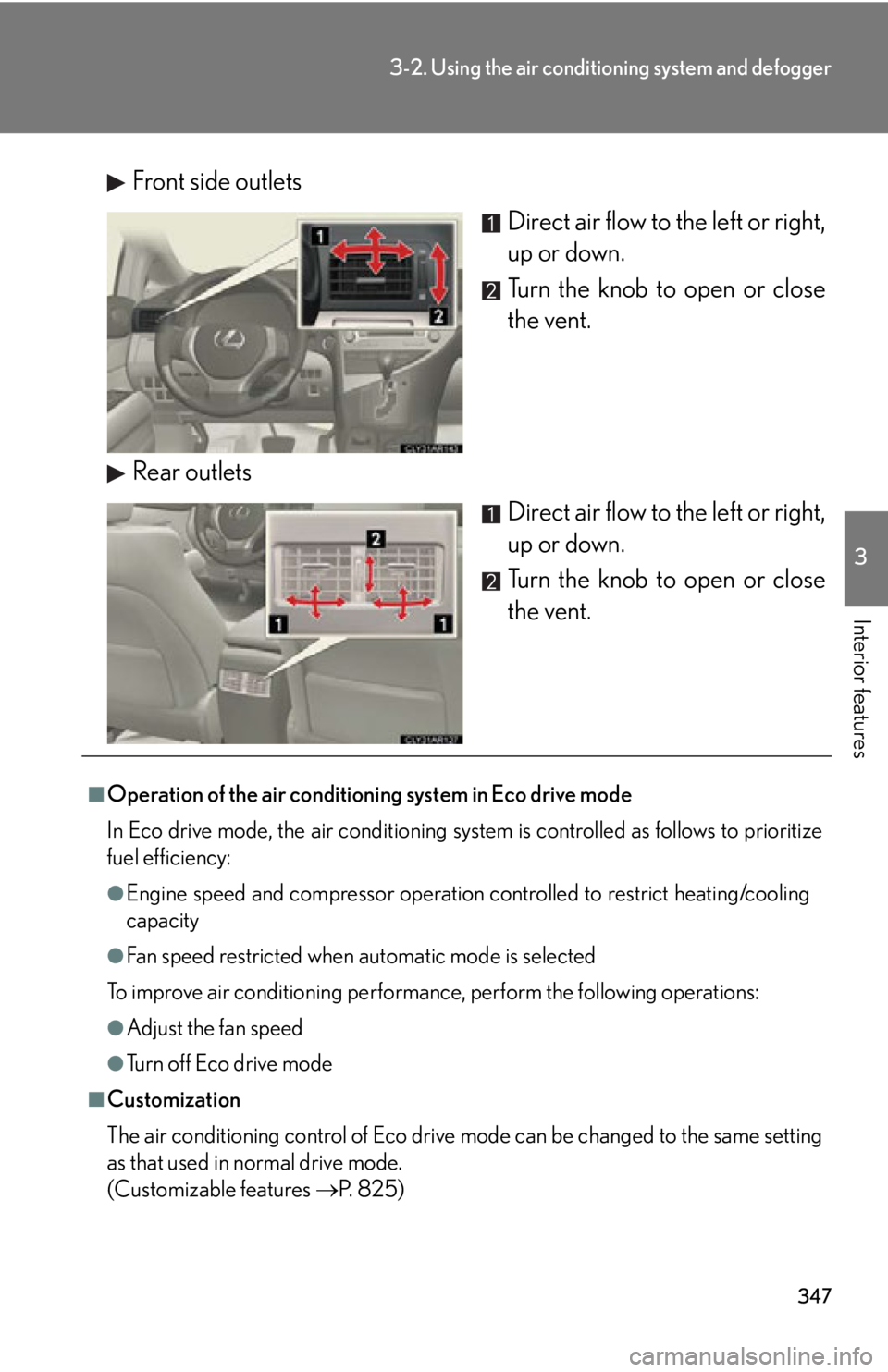
3473-2. Using the air conditio ning system and defogger
3
Interior features Front side outlets
Direct air flow to the left or right,
up or down.
Turn the knob to open or close
the vent.
Rear outlets
Direct air flow to the left or right,
up or down.
Turn the knob to open or close
the vent.
■
Operation of the air conditioning system in Eco drive mode
In Eco drive mode, the air conditioning syst em is controlled as follows to prioritize
fuel efficiency: ●
Engine speed and compressor operation controlled to restrict heating/cooling
capacity●
Fan speed restricted when automatic mode is selected
To improve air conditioning performanc e, perform the following operations:●
Adjust the fan speed
●
Turn off Eco drive mode
■
Customization
The air conditioning control of Eco drive mode can be changed to the same setting
as that used in normal drive mode.
(Customizable features P. 825)
Page 355 of 878
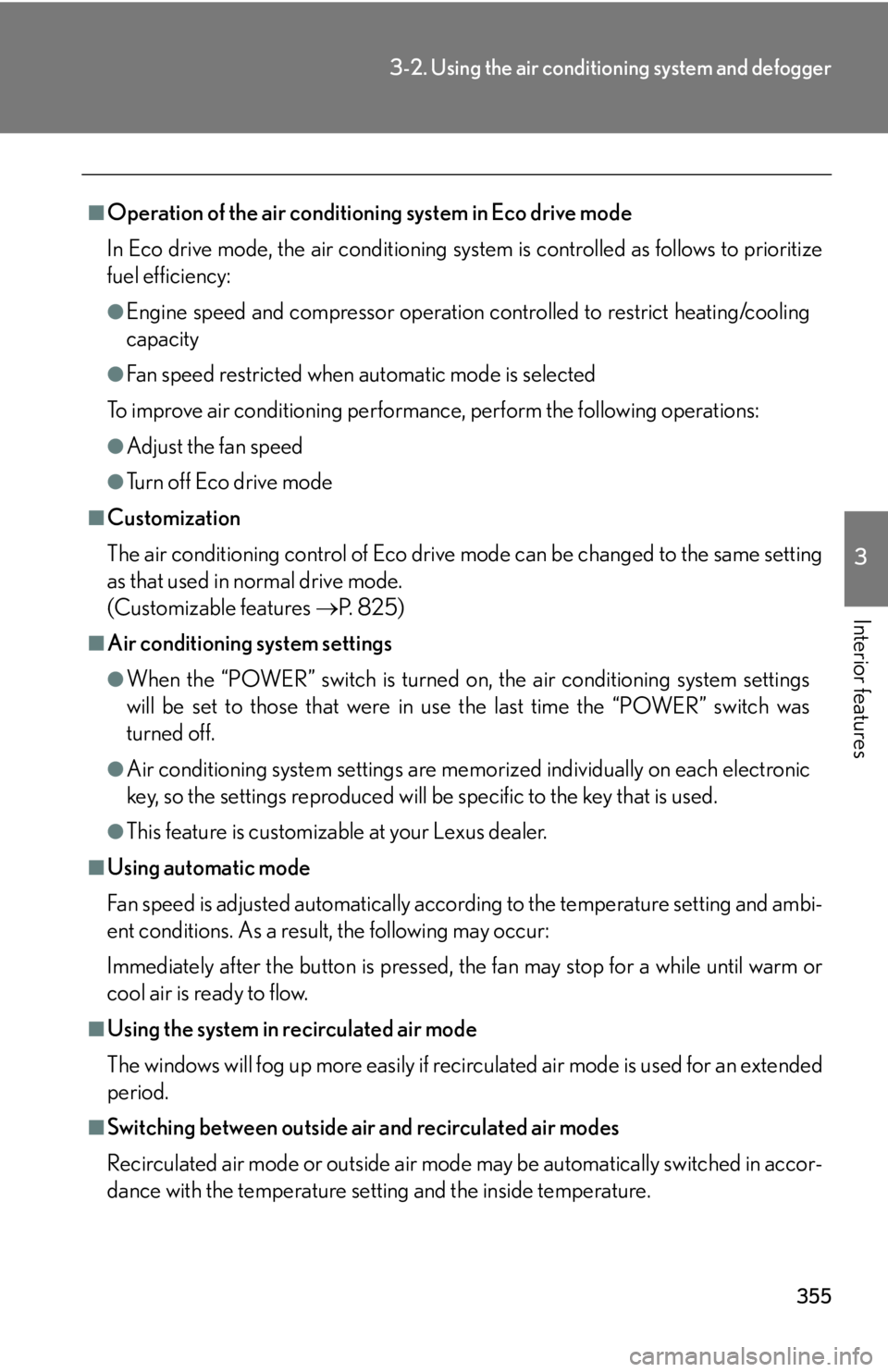
3553-2. Using the air conditio ning system and defogger
3
Interior features ■
Operation of the air conditioning system in Eco drive mode
In Eco drive mode, the air conditioning syst em is controlled as follows to prioritize
fuel efficiency: ●
Engine speed and compressor operation controlled to restrict heating/cooling
capacity●
Fan speed restricted when automatic mode is selected
To improve air conditioning performanc e, perform the following operations:●
Adjust the fan speed●
Turn off Eco drive mode■
Customization
The air conditioning control of Eco drive mode can be changed to the same setting
as that used in normal drive mode.
(Customizable features P. 825)■
Air conditioning system settings ●
When the “POWER” switch is turned on, the air conditioning system settings
will be set to those that were in use the last time the “POWER” switch was
turned off.●
Air conditioning system settings are memorized individually on each electronic
key, so the settings repr oduced will be specific to the key that is used.●
This feature is customizable at your Lexus dealer.■
Using automatic mode
Fan speed is adjusted automatically accord ing to the temperature setting and ambi-
ent conditions. As a result, the following may occur:
Immediately after the button is pressed, the fan may stop for a while until warm or
cool air is ready to flow.■
Using the system in recirculated air mode
The windows will fog up more easily if recirculated air mode is used for an extended
period.
■
Switching between outside air and recirculated air modes
Recirculated air mode or outside air mode may be automatically switched in accor-
dance with the temperature setting and the inside temperature.
Page 459 of 878
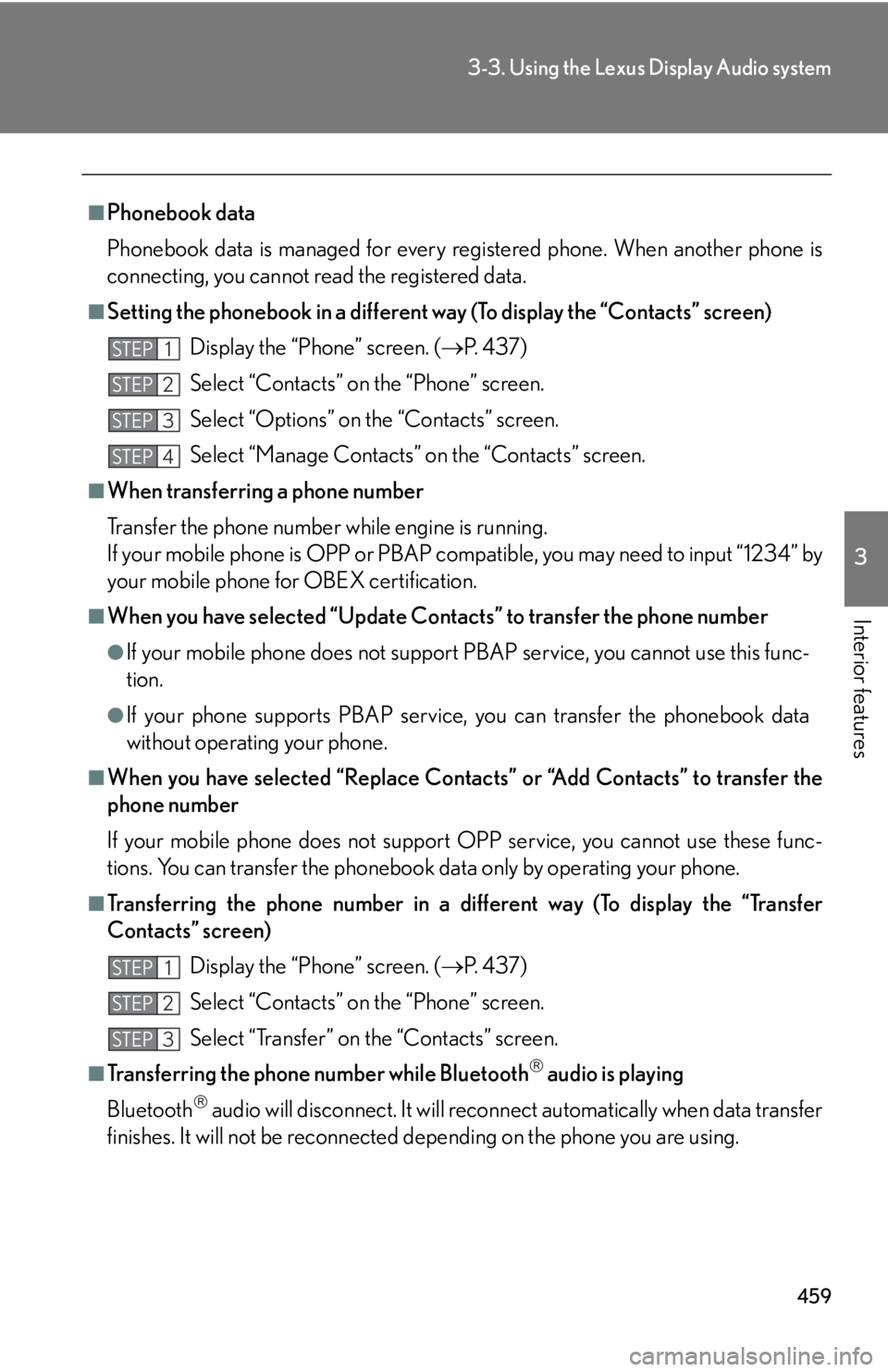
4593-3. Using the Lexus Display Audio system
3
Interior features ■
Phonebook data
Phonebook data is managed for every registered phone. When another phone is
connecting, you cannot read the registered data.■
Setting the phonebook in a different wa y (To display the “Contacts” screen)
Display the “Phone” screen. ( P. 4 3 7 )
Select “Contacts” on the “Phone” screen.
Select “Options” on the “Contacts” screen.
Select “Manage Contacts” on the “Contacts” screen.■
When transferring a phone number
Transfer the phone number while engine is running.
If your mobile phone is OPP or PBAP co mpatible, you may need to input “1234” by
your mobile phone for OBEX certification.■
When you have selected “Update Cont acts” to transfer the phone number●
If your mobile phone does not support PBAP service, you cannot use this func-
tion.●
If your phone supports PBAP service, you can transfer the phonebook data
without operating your phone.■
When you have selected “Replace Contacts” or “Add Contacts” to transfer the
phone number
If your mobile phone does not support OPP service, you cannot use these func-
tions. You can transfer the phonebook data only by operating your phone.■
Transferring the phone number in a different way (To display the “Transfer
Contacts” screen)
Display the “Phone” screen. ( P. 4 3 7 )
Select “Contacts” on the “Phone” screen.
Select “Transfer” on the “Contacts” screen.
■
Transferring the phone number while Bluetooth
audio is playing
Bluetooth
audio will disconnect. It will reconnect automatically when data transfer
finishes. It will not be reconnected depending on the phone you are using. STEP 1
STEP 2
STEP 3
STEP 4
STEP 1
STEP 2
STEP 3
Page 631 of 878
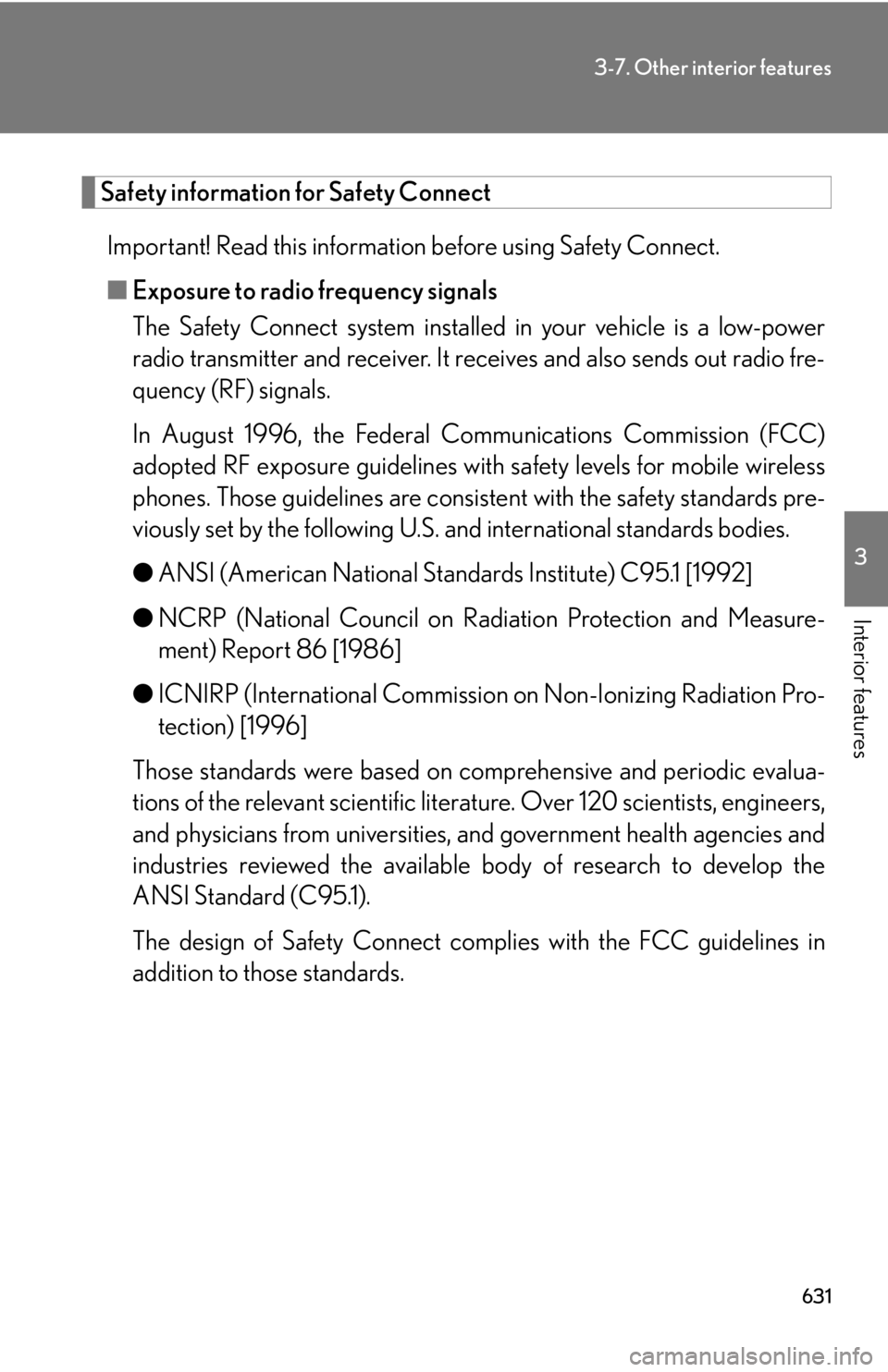
6313-7. Other interior features
3
Interior features Safety information for Safety Connect
Important! Read this information before using Safety Connect.
■ Exposure to radio frequency signals
The Safety Connect sy stem installed in your vehicle is a low-power
radio transmitter and receiver. It receives and also sends out radio fre-
quency (RF) signals.
In August 1996, the Federal Communications Commission (FCC)
adopted RF exposure guidelines with safety levels fo r mobile wireless
phones. Those guidelines are consistent with th e safety standards pre-
viously set by the following U.S. and international standards bodies.
● ANSI (American National Standards Institute) C95.1 [1992]
● NCRP (National Council on Radiation Protection and Measure-
ment) Report 86 [1986]
● ICNIRP (International Commission on Non-Ionizing Radiation Pro-
tection) [1996]
Those standards were based on co mprehensive and periodic evalua-
tions of the relevant scientific literature. Over 120 scientists, engineers,
and physicians from universities, an d government health agencies and
industries reviewed the available body of research to develop the
ANSI Standard (C95.1).
The design of Safety Connect co mplies with the FCC guidelines in
addition to those standards.
Page 633 of 878
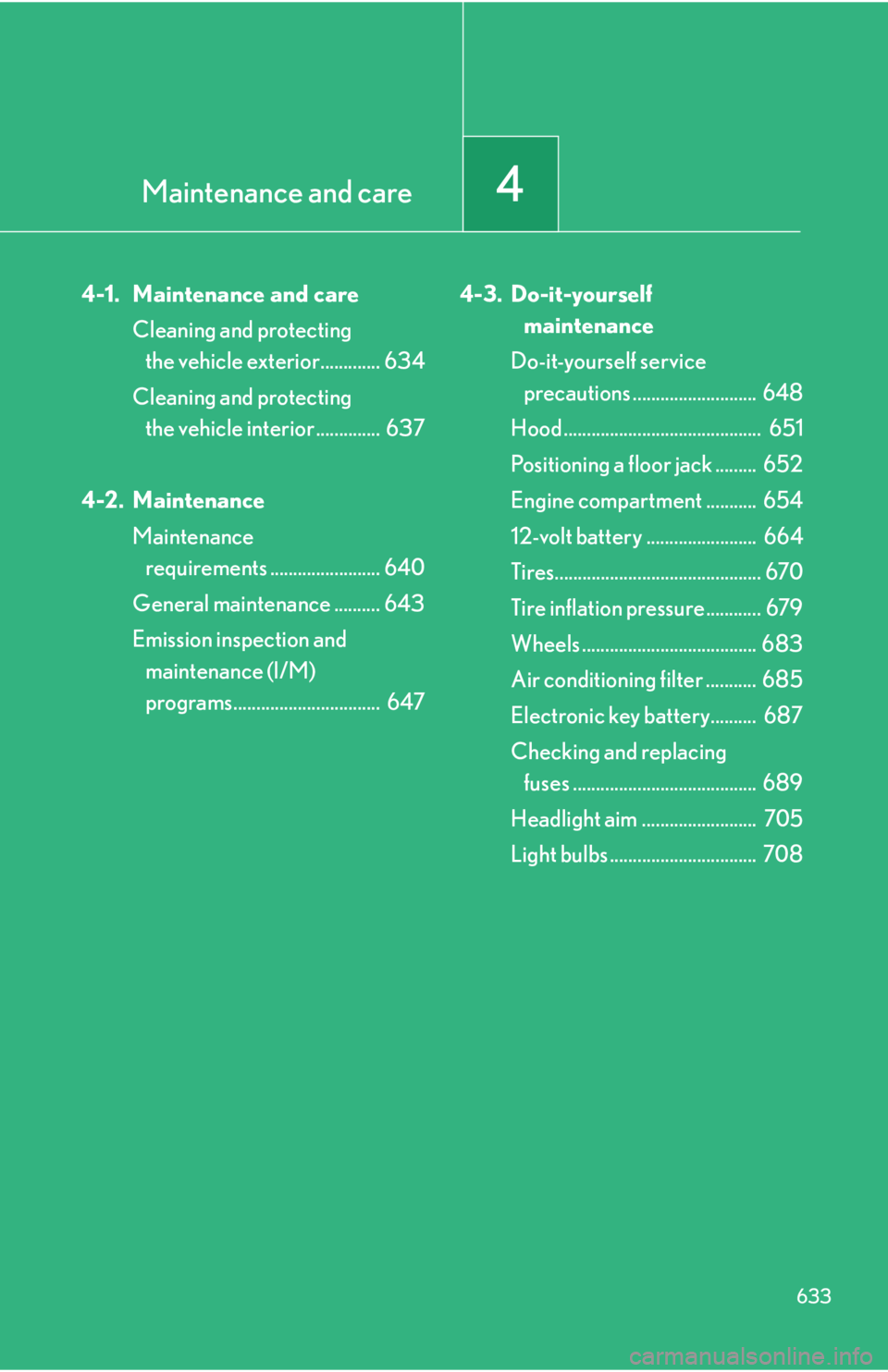
Maintenance and care
4
6334-1. Maintenance and care
Cleaning and protecting
the vehicle exterior............. 634
Cleaning and protecting
the vehicle interior .............. 637
4-2. Maintenance
Maintenance
requirements ........................ 640
General maintenance .......... 643
Emission inspection and
maintenance (I/M)
programs................................ 647 4-3. Do-it-yourself
maintenance
Do-it-yourself service
precautions ........................... 648
Hood ........................................... 651
Positioning a floor jack ......... 652
Engine compartment ........... 654
12-volt battery ........................ 664
Tires............................................. 670
Tire inflation pressure............ 679
Wheels ...................................... 683
Air conditioning filter ........... 685
Electronic key battery.......... 687
Checking and replacing
fuses ........................................ 689
Headlight aim ......................... 705
Light bulbs ................................ 708
Page 642 of 878
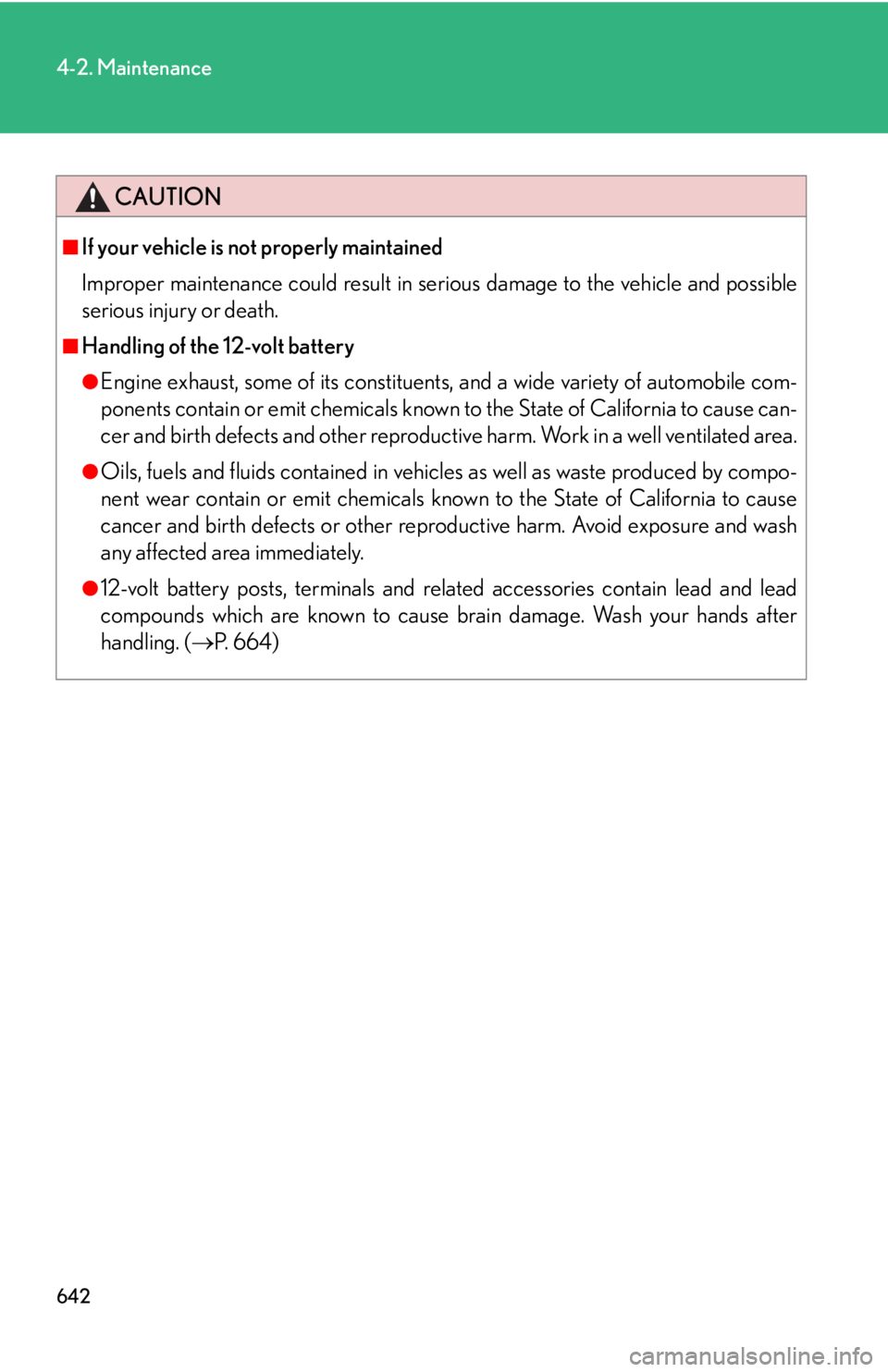
6424-2. Maintenance
CAUTION■
If your vehicle is not properly maintained
Improper maintenance could result in se rious damage to the vehicle and possible
serious injury or death.■
Handling of the 12-volt battery ●
Engine exhaust, some of its constituents, and a wide variety of automobile com-
ponents contain or emit chemicals known to the State of California to cause can-
cer and birth defects and other reproductive harm. Work in a well ventilated area.●
Oils, fuels and fluids contained in vehicles as well as waste produced by compo-
nent wear contain or emit chemicals known to the State of California to cause
cancer and birth defects or other reproductive harm. Avoid exposure and wash
any affected area immediately.●
12-volt battery posts, terminals and related accessories contain lead and lead
compounds which are known to cause brain damage. Wash your hands after
handling. ( P. 6 6 4 )
Page 643 of 878
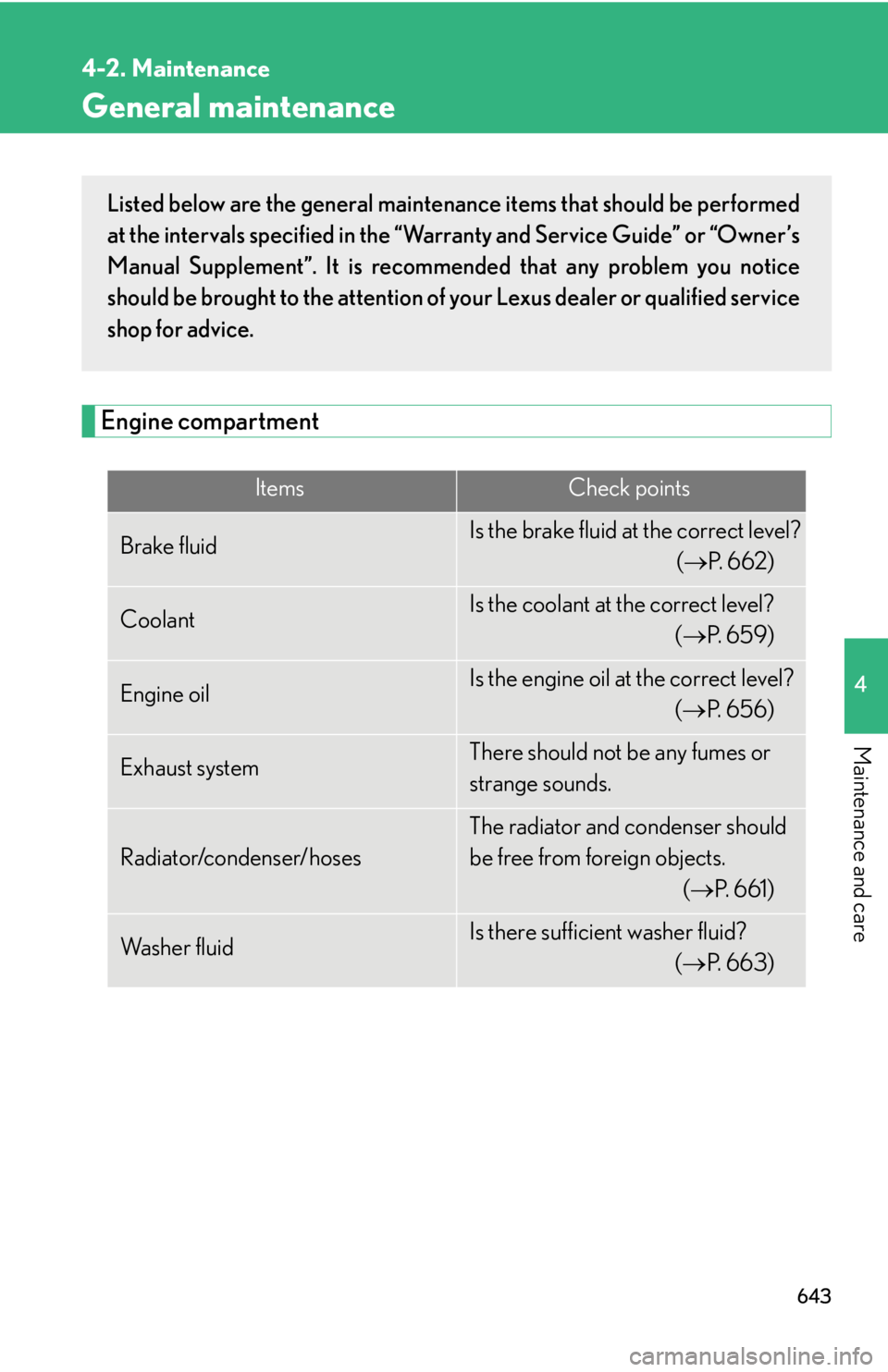
6434-2. Maintenance
4
Maintenance and care General maintenance
Engine compartment Items Check points
Brake fluid Is the brake fluid at the correct level?
( P. 6 6 2 )
Coolant Is the coolant at the correct level?
( P. 6 5 9 )
Engine oil Is the engine oil at the correct level?
( P. 6 5 6 )
Exhaust system There should not be any fumes or
strange sounds.
Radiator/condenser/hoses The radiator and condenser should
be free from foreign objects.
( P. 6 6 1 )
Wa s h e r f l u i d Is there sufficient washer fluid?
( P. 663)Listed below are the general maintenance items that should be performed
at the intervals specified in the “Warranty and Service Guide” or “Owner’s
Manual Supplement”. It is recomme nded that any problem you notice
should be brought to the attention of your Lexus dealer or qualified service
shop for advice.